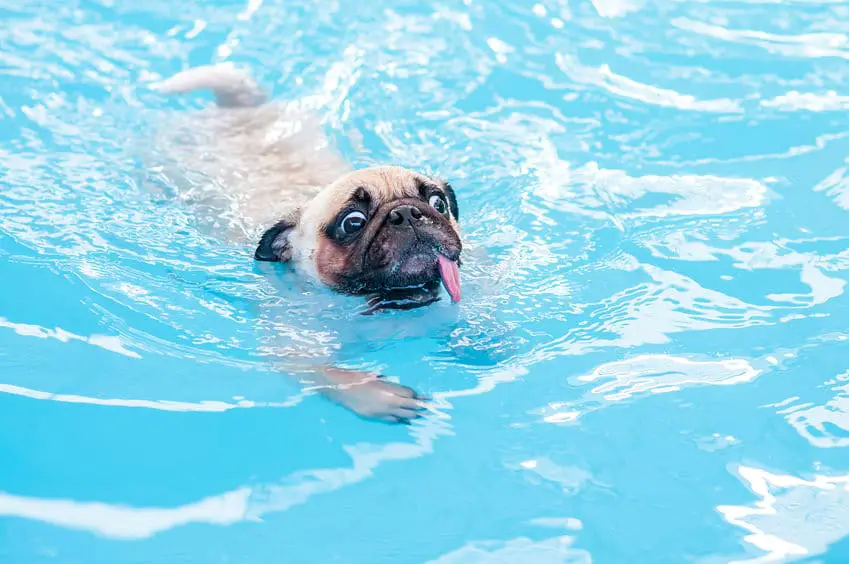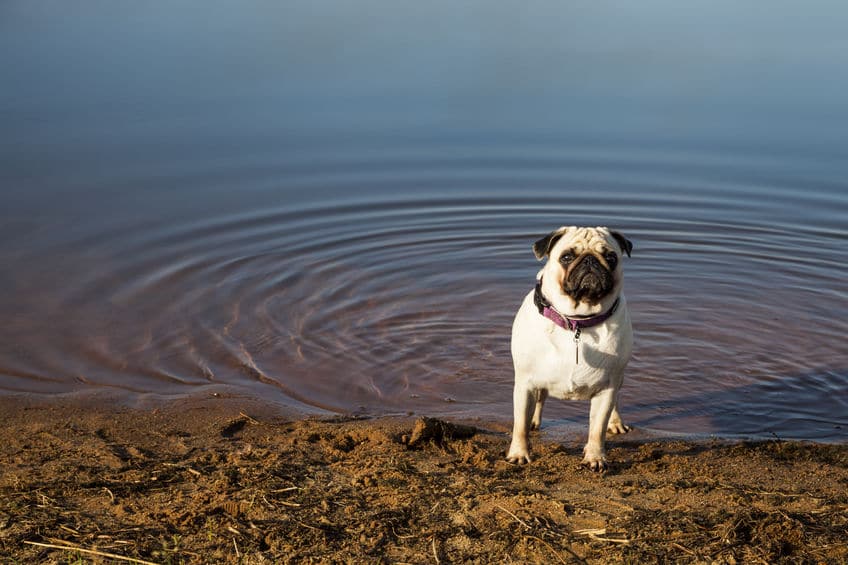Its summer, blazing hot and the pool, lake or beach looks really appealing, you grab your family, friends, and your Pug. Now you are wondering, can Pugs swim because your Pug has never been in a large body of water before?
Pugs can swim, this largely due to their basic natural instincts, but they aren’t natural-born swimmers. This is also due to certain factors such as their body-weight distribution.
There are other conditions you have to take into account that would either make your time out in the pool or lake a pleasant experience for you and your Pug or, a trip to the vet with your Pug’s health hanging in the balance.
In this blog post, I have done my research, taken personal knowledge, and experience into account to help ensure your swimming trip stays fun and safe.
First, we need to understand if Pugs enjoy swimming in the first place, if they can swim in chlorinated pools, at the lake, or at the beach, in saltwater. The risks involved amongst other things.
So, let’s begin.
Do Pugs like swimming?
Taking your pug to the pool is one thing and having your pug excitedly jump in to swim is another.
Not all Pugs would enjoy swimming so it is necessary to first introduce them tactfully and patiently to large bodies of water.

Never throw your Pug or any dog for that matter into a pool or lake, as the impact could cause injuries and your dog might end up having a negative association with large bodies of water.
It is advised to start with a kiddies pool if you own one, or maybe the bathtub. Getting them to understand their abilities in a smaller sized body of water would help build up their confidence before introducing a larger sized body of water.
Can Pugs Swim in the Beach (Salt Water)?
Going to the beach can be a fun experience for you and your dog, playing in the sand and watching the wave roll in. That being said, it is important to know if you should take your Pug out into the water.
Pugs can swim at the beach but this would be a risky thing to do and I strongly advise against it and here is why; you stand the risk of having your Pug being swept away by a strong ocean wave or the risk of ingesting salt water, resulting in salt poisoning.
When salt is ingested in large quantities, it can cause some severe health issues. Issues such as seizures, injury to the kidneys, a loss of brain cells, and severe dehydration.
If a dog with saltwater poisoning isn’t treated medically, the condition can escalate and lead to death src.
A recognizable symptom of salt poisoning is a change in behavior, your Pug would act confused due to a large amount of sodium in its body.
Other symptoms may include weakness, diarrhea, muscle tremors, and seizures.
It is advisable to set aside freshwater in case your Pug ingests the ocean water (saltwater), in this case the freshwater should be offered and he/she should be kept under a shade and watched carefully for toxicity.
Take breaks every 5 minutes to reduce the chances of salt poisoning src.
Also employ the use of life jackets when at the beach.
Should Pugs Swim in Chlorinated Swimming Pools?
According to Chemical Safety facts, “Chlorine is added to the water to kill germs. When it is added to a swimming pool, it forms a weak acid called hypochlorous acid that kills bacteria like salmonella and E. coli, as well as germs that cause viruses such as diarrhea and swimmer’s ear”.
Pugs can swim in chlorinated swimming pools as long as the level of chlorine added is negligible and safe for swimming.
Pugs are known to have sensitive skin and with their eyes being so pronounced, they stand the risk of reacting to the chlorine in the pool, therefore, it is important to also monitor your Pug while swimming in a chlorinated pool.

It is important to keep the chlorine tablets away from your Pugs reach because they can be fatal if ingested. Alternatively, you could use Bromine for your pool, which is a safer alternative for pets.
According to the American Kennel Club, some best practices to always remember when going for a swim in a chlorinated pool with your Pug include:
- Ensure your Pug is trained to not lick or drink the pool water, as it could result in complications. Keep an eye on him/her to prevent this from happening.
- Keep fresh water handy in case your Pug accidentally or intentionally ingests the pool water.
- Rinse your Pug with fresh water after it hops out of the pool. This is to remove any excess chemicals left on its skin.
- Dry up your Pug with a dry towel, ensuring any remaining pool water is dabbed off their ears, wrinkles, and fur.
Can Pugs Swim at the Lake?
If you live close to a lake or go camping along a lake, taking the occasional dive in and swim would be a no-brainer.
Now, pausing to wonder if your Pug can swim with you would be a responsible thing to do.
Yes, Pugs can go swimming at the lake, but, like always, there are certain things you have to consider before you take your Pug into the lake.

There are certain precautions to take note of and i have made my research to compile most, if not all, below:
- First, do some research on the lake you intend to swim in. Ensure it’s safe for you and your Pug
- Stay clear slow-flowing or stagnant pools which are common during the late summer season, as they could be harboring brain-eating amoeba often found in hot, stagnant water src.
- Ensure your Pug doesn’t lick or drink the lake water as he/she could stand the risk of blue-green algae poisoning -– Blue-green algae are toxic to dogs when consumed in high volume, and they are commonly found in hot, slow-flowing and stagnant water src.
- Watch out for water snakes and any water-dwelling animal that can pose a threat to you and your Pug. As a cautionary note, do not leave your dog unattended.
- Keep an eye out for objects such as broken glasses (bottles), fishing lines and hooks, sharp sticks, or metals that could harm your Pug, especially in the eyes.
- Carry a doggy first aid kit on every of your lake swimming trip in case of an emergency.
- If you go swimming in salmon or trout contained lakes, maybe around the Pacific Northwest of the US or in British Columbia, Canada, you have to pay attention to prevent your Pug from eating any salmon.
He/she risks getting salmon poison.
Salmon, and other salmonid fish (incl. trout, char, and others), in these parts of North America, can contain a type of bacteria and a parasitic fluke (a kind of worm) src. - Take fresh water with you to keep your Pug hydrated and prevent it from drinking the lake water when tasty.
- Always rinse your dog off with fresh water after a swim session and wipe dry with a clean towel, be sure to clean its wrinkles as well.
Some symptoms to reveal that your dog might be experiencing blue-green algae poisoning include diarrhea or vomiting, drooling, neurologic signs such as weakness, disorientation/confusion, collapse/unconsciousness, seizures, and breathing difficulties.
The Risks Associated with Swimming
As you might have guessed, having read this far, taking your Pug swimming isn’t all sunshine and rainbows. Apart from the obvious risk which is drowning, there are other lesser-known risks involved and in this section, I will be exploring two and going into details on them.
Water Intoxication
Water intoxication, also known as water poisoning, hyperhydration, and water toxemia, is caused as a result of excess water intake during swimming.
Due to the Pug’s tiny size, it would find it harder to remove this excess water from its system, putting him/her at a higher risk than larger dogs.
According to the American Kennel Club, when a dog experiences water intoxication, the sodium levels outside the cells are depleted, a condition called hyponatremia. In an effort to rebalance itself, the body responds to the low blood sodium by increasing fluid intake inside the cells.
Some organs, such as the liver, can accommodate the increased volume of their swelling cells, but others — in particular, the brain, which is encased in bone — cannot.
Some notable symptoms of water intoxication include bloating, drooling, vomiting, lethargy, loss of coordination (including stumbling, falling, or staggering), dilated pupils, restlessness, pale gums, and glazed eyes src.
Water intoxication can be prevented by taking breaks in between swimming to let your Pug rest, watch his swimming style, if his head ever goes underwater, there are greater chances of him/her ingesting excess water which in-turn leads to water intoxication.
Leptospirosis
Leptospirosis is a disease that can affect dogs. It is carried by rats, wildlife and domestic livestock, with most cases seen in late summer and fall and often after heavy rainfalls.
The organism that causes leptospirosis is called spirochete bacteria and can be found throughout the world.
It is known to exist in stagnant pool of water, mud, and dampness. Dogs have been known to contract leptospirosis by swimming or drinking stagnant pools infested with the bacteria.
Leptospirosis doesn’t necessarily make your dog visibly ill, but when it does some signs of illness could include lethargy, poor appetite, fever, vomiting, increased thirst, or urine production. It takes 4-12 days before symptoms become visible.
It is important to vaccinate your Pug because unvaccinated dogs stand a higher chance of getting ill from being infected with Leptospirosis.
A major step to prevent this is to keep your Pug away from a stagnant, non-flowing pool of water. Your swimming pool at home is not included as long as it’s treated with chlorine or bromine.
Away from the subject of swimming, leptospirosis can also be transmitted through the urine of rats, raccoons, feral cats, and other animals, so keep your house, Pug’s crate or playpen clean to reduce the chances of rat visits your and Pug getting infected.
Leptospirosis is also a zoonotic disease, meaning humans can contract it as well. This can happen when your dog licks your face or when you come in contact with their urine.
Training your Pug to Swim
As earlier stated, it is advisable to begin swimming training when your Pug is a puppy, getting it familiar with water early on. A kiddie pool would also be advised at this very young age.
It is important to start out your dog’s swimming lessons with a life jacket as well, this would help your Pug to adjust properly in the new experience of being in the water without having to tire itself out too quickly in a panic frenzy.
The life jacket should be worn way before the swimming training begins, this would help ensure your Pug gets used to wearing one. You can put it on him/her during feed hours to help create a positive association with it.
It is advisable to buy a life jacket with a handle and a D-ring to help ensure you can assist and guide your dog when it is in the water src.
That being said, here is a list of steps to take while training your Pug to swim:
- Start from a shallow area of the pool or lake to get its feet wet and do not advance until it is comfortable with being there. This should be done with a leash attached, hence the reason you should get a lifejacket with a D-ring.
- Attract its interest with treats as you gradually venture further into the deeper areas.
- You can use your Pug’s favorite toy to lure him further into the deeper area, enough to get him paddling and swimming towards you.
- Be at hand to help your dog in the event of a panic.
- Keep the training sessions short and fun, rewarding your Pug with treats after every milestone.
- It is important to also teach your Pug how to exit the pool or lake, preferably, how it came in.
Safety Tips
In this section, I will be compiling safety tips you need to take into account when you need to take your Pug swimming.
- Always remember, your Pug isn’t a natural-born swimmer, therefore never leave him/her unattended.
- Always put a lifejacket on your Pug when you go swimming, this is to help keep your Pug safe as well as put your mind at ease.
- Never let your Pug drink the water from the pool, lake, or beach. Most importantly, never let it drink from a stagnant pool of water.
- If you own a pool at home, investing in a pool cover could go a long way in preventing any form of accident.
- Pugs are sensitive to hot and cold weather, always ensure the temperature of the water is idle for a swim.
- Keep freshwater around whenever you go swimming.
- Finally, always carry a dog first aid kit when you go swimming at the lake in case of an accident.
In conclusion, taking your Pug out for a swim can be a great way to exercise him because Pugs are prone to obesity due to their gluttony nature.
It could also serve as a great bonding exercise between you and your dog, drawing you closer together.
So, let us know if you will be taking your Pug out on the water. You can also send us an email if you feel we missed something.

